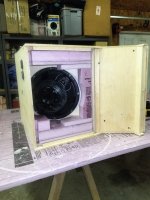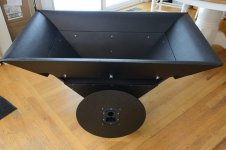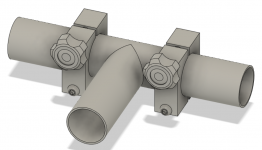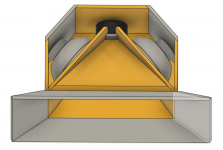Hi
I'm Alessandro from Italy
My english is not very good.
This is my first synergy project. I've planned it for many months reading almost every threads about MEH on the web especially on diyaudio so I deciced to subcribe here and say BIG THANK YOU for the immense knowledge and passion
without being hungry when different opinions are involved
(italian forums are diametrically opposite, my bad).
My idea was initially to replace 2x MACKIE SA1521 (133db max and 46kg) with
something with same or higher spl and less weight and max same dimensions to fit on a wagon car.
Immediatly I've found BFM DR series, good sensitivity but not high power handling.
When I've seen first Synergy pictures and threads I felt in love
In the same time the Peter Morris PM90 i think are no brainer for quality, dispersion, high output, dimension and weight.
So I decided to design a 80x50 Synergy with:
2x rcf mb12n351
1x b&c dcx464
YES the same drivers suitable for PM90.
So if my synergy attemp is crap I will make pm90.
Tomorrow maybe the drivers will arrive from TLHP-france.
maybe the drivers will arrive from TLHP-france.
I have a diy steel 900mmx450mmx170mm so I would use for this project.
Meanwhile I have some questions:
1-80x50 coverage is good for me because I can implement 2x12 in 600Wx350Hx430DEPTH and horizontal pattern control is 300hz according to Bwalso speadsheet v5 (immense thank you) but is unual for a synergy, however is exactly 1.6 ratio.
2- with coax CD I can cover mids without cones and mid ports location "problem" so can I move 12"s a little far away from CD?
3-I want to extend frequecy to 100-110hz to use with subs. My hornresp AP-AP1 parameter selections are correct simulating reflex ports inside the horn?
4- on diyaudio DCX464 I read throat exit angle of this driver is 0°. I've tried to design on Fusion 360 (loft function) a round to rectangle using 80x50 angles to smooth CD throat. Can I have problem with distortion? Can I do it better maybe with first segment at 0°?
In Attached Hornresp 4pi simulations, Designs on Fusion without secondary flare.
Thank you very much
Ale
View attachment 956830
View attachment 956831
View attachment 956832
View attachment 956833
View attachment 956834
View attachment 956835
View attachment 956836
I'm Alessandro from Italy
My english is not very good.
This is my first synergy project. I've planned it for many months reading almost every threads about MEH on the web especially on diyaudio so I deciced to subcribe here and say BIG THANK YOU for the immense knowledge and passion
without being hungry when different opinions are involved
(italian forums are diametrically opposite, my bad).
My idea was initially to replace 2x MACKIE SA1521 (133db max and 46kg) with
something with same or higher spl and less weight and max same dimensions to fit on a wagon car.
Immediatly I've found BFM DR series, good sensitivity but not high power handling.
When I've seen first Synergy pictures and threads I felt in love
In the same time the Peter Morris PM90 i think are no brainer for quality, dispersion, high output, dimension and weight.
So I decided to design a 80x50 Synergy with:
2x rcf mb12n351
1x b&c dcx464
YES the same drivers suitable for PM90.
So if my synergy attemp is crap I will make pm90.
Tomorrow
I have a diy steel 900mmx450mmx170mm so I would use for this project.
Meanwhile I have some questions:
1-80x50 coverage is good for me because I can implement 2x12 in 600Wx350Hx430DEPTH and horizontal pattern control is 300hz according to Bwalso speadsheet v5 (immense thank you) but is unual for a synergy, however is exactly 1.6 ratio.
2- with coax CD I can cover mids without cones and mid ports location "problem" so can I move 12"s a little far away from CD?
3-I want to extend frequecy to 100-110hz to use with subs. My hornresp AP-AP1 parameter selections are correct simulating reflex ports inside the horn?
4- on diyaudio DCX464 I read throat exit angle of this driver is 0°. I've tried to design on Fusion 360 (loft function) a round to rectangle using 80x50 angles to smooth CD throat. Can I have problem with distortion? Can I do it better maybe with first segment at 0°?
In Attached Hornresp 4pi simulations, Designs on Fusion without secondary flare.
Thank you very much
Ale
View attachment 956830
View attachment 956831
View attachment 956832
View attachment 956833
View attachment 956834
View attachment 956835
View attachment 956836
Sorry I don't know why
I try with imgbb
https://ibb.co/Q6TZnSn
[url=https://ibb.co/H25N7dp]HORNRESP-DISPL — ImgBB[/url]
[url=https://ibb.co/ngLjPt0]HORNRESP-GRUP-DELAY — ImgBB[/url]
[url=https://ibb.co/MgsvJFF]HORNRESP-RESPONSE — ImgBB[/url]
[url=https://ibb.co/0J5JJhG]HORNRESP-DATA — ImgBB[/url]
[url=https://ibb.co/wz8NNDh]1-4-TO-80-X50-ALLUMINIUM-ADAPTER — ImgBB[/url]
https://ibb.co/bRqvN67
I try with imgbb
https://ibb.co/Q6TZnSn
[url=https://ibb.co/H25N7dp]HORNRESP-DISPL — ImgBB[/url]
[url=https://ibb.co/ngLjPt0]HORNRESP-GRUP-DELAY — ImgBB[/url]
[url=https://ibb.co/MgsvJFF]HORNRESP-RESPONSE — ImgBB[/url]
[url=https://ibb.co/0J5JJhG]HORNRESP-DATA — ImgBB[/url]
[url=https://ibb.co/wz8NNDh]1-4-TO-80-X50-ALLUMINIUM-ADAPTER — ImgBB[/url]
https://ibb.co/bRqvN67
HI this is hornresp export file
Let me know if you can see the file
Thank you
Ale
View attachment 80X50 MB12N351.txt
Let me know if you can see the file
Thank you
Ale
View attachment 80X50 MB12N351.txt
Hi petterhaus, yes pls do get attachments working...
I've done the very build you describe, same drivers, et al, although not nearly in such a small box. Can't wait to see what you've come up with.
PS...i think your logic of being able to default back to the PM90 is some super sound thinking about outcomes
I've done the very build you describe, same drivers, et al, although not nearly in such a small box. Can't wait to see what you've come up with.
PS...i think your logic of being able to default back to the PM90 is some super sound thinking about outcomes
It opened fine, thanks!
Not really up to speed using HR's multiple horn entry, so not sure why the notch at ~640 Hz unless it's an eigenmode across the driver cone since it's ~10.6" long.
Hi
Thank you
I Need to investigate about the notch bit i think
To xover the dcx in this 650-700 range so maybe i can mitigate the problem.
I see now i forgot to mention the dimensions on the First post are for the primary horn. The secondary flare Is near 950x600mm and mobile like Dixie cap in syntripp so i can Hide secondary flare between front and rear seats in my car.
I Hope this evening to continue ti design the cabinet.
Ale
Thank you
I Need to investigate about the notch bit i think
To xover the dcx in this 650-700 range so maybe i can mitigate the problem.
I see now i forgot to mention the dimensions on the First post are for the primary horn. The secondary flare Is near 950x600mm and mobile like Dixie cap in syntripp so i can Hide secondary flare between front and rear seats in my car.
I Hope this evening to continue ti design the cabinet.
Ale
Idle question: coax CD = shortcut to pseudo-Synergy?
Good luck with your project, Alesandro! I've never done it in car audio, and I have a "real" if older Unity speaker at home -- the Yorkville U15. I'm happy with them and in no hurry to replace them.
This thread has me idly wondering: why not use a coaxial (mid-hi) compression driver for a Unity/Synergy? Now, I know it would not be a "true" one of those -- midrange ports, benefit of low pass filter on the mids, etc. Not to mention it'd remove a lot of the challenge to build a "true" Synergy. Also, aren't these coax CDs quite expensive?
No matter. Doesn't this give you 95% of what a Synergy is supposed to do?
With a suitable 15" or larger horn, it would give you the same virtual point source and pattern control down to about 300 Hz, which is the cutoff of these CDs (e.g. the BMS line) or, for that matter, the U15's horn. Can it be that simple? I doubt it. What am I overlooking? Diffraction within the CD itself?
I must be overlooking something! Otherwise wouldn't more people have built this, since it would be 100% off the shelf parts?
Good luck with your project, Alesandro! I've never done it in car audio, and I have a "real" if older Unity speaker at home -- the Yorkville U15. I'm happy with them and in no hurry to replace them.
This thread has me idly wondering: why not use a coaxial (mid-hi) compression driver for a Unity/Synergy? Now, I know it would not be a "true" one of those -- midrange ports, benefit of low pass filter on the mids, etc. Not to mention it'd remove a lot of the challenge to build a "true" Synergy. Also, aren't these coax CDs quite expensive?
No matter. Doesn't this give you 95% of what a Synergy is supposed to do?
With a suitable 15" or larger horn, it would give you the same virtual point source and pattern control down to about 300 Hz, which is the cutoff of these CDs (e.g. the BMS line) or, for that matter, the U15's horn. Can it be that simple? I doubt it. What am I overlooking? Diffraction within the CD itself?
I must be overlooking something! Otherwise wouldn't more people have built this, since it would be 100% off the shelf parts?
Chris A, Rick McInnis have already done it with the new Celestion, Klipsch K402: A K-402-Based Full-Range Multiple-Entry Horn - Technical/Modifications - The Klipsch Audio Community
Rick's nearby and been trying to get me over for an audition, but 'life' keeps happening, though 'hope springs eternal'.........
Rick's nearby and been trying to get me over for an audition, but 'life' keeps happening, though 'hope springs eternal'.........
Hi Alesandro,
I've been trying to find the Hornresp files from my mb12n351 synergy build, to help give better comments.
Can't find them, but i remember using HR's MEH (as opposed to OD) input screens, and i remember an overall response that looks similar to what you linked.
My horn was a 60x40....doubt if that matters much.
Also remember it helped to reduce the Vrc as much as possible. I ended up packing the cavity with blocks of XPS foamboard to reduce volume.
Where are you planning to put the ports?

I've been trying to find the Hornresp files from my mb12n351 synergy build, to help give better comments.
Can't find them, but i remember using HR's MEH (as opposed to OD) input screens, and i remember an overall response that looks similar to what you linked.
My horn was a 60x40....doubt if that matters much.
Also remember it helped to reduce the Vrc as much as possible. I ended up packing the cavity with blocks of XPS foamboard to reduce volume.
Where are you planning to put the ports?

HI GUYS!
For Soldermizer:
You are right, it can be seen like a "fake Synergy", i leave out some midranges design problems and using coax is far from the synergy philosophy and theory but my challenge is not to build a real synergy by force of circumstances.
Yes DCX is expensive but like i said if I want I can build PM90 instead after.
I've read in another thread SH96HO have a coax for improve output instead of 1" faital and 6 mids? Is right?
sorry but I can't understand this
"I must be overlooking something! Otherwise wouldn't more people have built this, since it would be 100% off the shelf parts?"
Can you explain? thank you
for GM
I've read some posts but not the entire thread. I read now
thank you
for Mark100
Thank you for the picture.
My thought was to cut rear woofer walls parallel to the magnets so I can gain
a little bit space outside and reduce internal volume and yes, use xps for other reduction. I've found for 20liters is good for vrc.
I've tried to modify "synergy port distance from throat" in the spreadsheet only to change L12 L23 lenght in HR to sim some port locations and around 2inches of L12 seems good.
But I don't know how to simulate right front woofer ports and front reflex ports in the same time. I don't know if my sim is near to real world.
I will post some cad picture soon.
Ale
For Soldermizer:
You are right, it can be seen like a "fake Synergy", i leave out some midranges design problems and using coax is far from the synergy philosophy and theory but my challenge is not to build a real synergy by force of circumstances.
Yes DCX is expensive but like i said if I want I can build PM90 instead after.
I've read in another thread SH96HO have a coax for improve output instead of 1" faital and 6 mids? Is right?
sorry but I can't understand this
"I must be overlooking something! Otherwise wouldn't more people have built this, since it would be 100% off the shelf parts?"
Can you explain? thank you
for GM
I've read some posts but not the entire thread. I read now
thank you
for Mark100
Thank you for the picture.
My thought was to cut rear woofer walls parallel to the magnets so I can gain
a little bit space outside and reduce internal volume and yes, use xps for other reduction. I've found for 20liters is good for vrc.
I've tried to modify "synergy port distance from throat" in the spreadsheet only to change L12 L23 lenght in HR to sim some port locations and around 2inches of L12 seems good.
But I don't know how to simulate right front woofer ports and front reflex ports in the same time. I don't know if my sim is near to real world.
I will post some cad picture soon.
Ale
Hmm, forgot to post this since it's so long: rickmcinnis - The Klipsch Audio Community
Hi
meanwhile i designed this module to give inclination ( i want to put some stoppers) and can be hidden under the down flare and is foldable inside cabinet space occupation. I would to built the horizontal pipe like a gear so it can't accidentally rotare because of the changing of barycentre.
INCLINABLE — ImgBB
meanwhile i designed this module to give inclination ( i want to put some stoppers) and can be hidden under the down flare and is foldable inside cabinet space occupation. I would to built the horizontal pipe like a gear so it can't accidentally rotare because of the changing of barycentre.
INCLINABLE — ImgBB
Attachments
Hi
meanwhile i designed this module to give inclination ( i want to put some stoppers) and can be hidden under the down flare and is foldable inside cabinet space occupation. I would to built the horizontal pipe like a gear so it can't accidentally rotare because of the changing of barycentre.
INCLINABLE — ImgBB
Super original tilt idea !!!
I don't think folks realize the engineering that needs to go into portable outside speakers.....
And I'm almost 100% convinced they haven't heard truly linear, and powerful, full spectrum systems outdoors.....or there would be greatly reduced indoor hi-fi audio focus anymore !
One thing i've learned the hard way though, with what you're working on.
Wind can really tug on a big horn.
I put a cheap Eminence tilt-able pole mount in this guy because it weighs less than 25 kilos. Holds the weight fine, but i need a rotational grip to keep it from spinning in the wind. Other wise it's bungee cords etc.
So my advice is to add some kinda anti-spin clamp, if you're using standard pole mounts.
(round bottom plate is removeable for cleaner pole mount look)

Hi
"And I'm almost 100% convinced they haven't heard truly linear, and powerful, full spectrum systems outdoors.....or there would be greatly reduced indoor hi-fi audio focus anymore"
Mark same thought
In my country wind is a dream! I bet I can't charge my phone with a wind generator here
however I will buy 2 sturdy pole pounts with big feet.
I post my progress with rear sides angled parallel to the woofer magnets.
immagine-2021-06-04-234614 — ImgBB
"And I'm almost 100% convinced they haven't heard truly linear, and powerful, full spectrum systems outdoors.....or there would be greatly reduced indoor hi-fi audio focus anymore"
Mark same thought
In my country wind is a dream! I bet I can't charge my phone with a wind generator here
however I will buy 2 sturdy pole pounts with big feet.
I post my progress with rear sides angled parallel to the woofer magnets.
immagine-2021-06-04-234614 — ImgBB
Attachments
Reply to GM re the K-402 MEH
Thanks for the link. I'd read about this project, but not in such a detailed post. I find Chris A's comments on page 6 very informative:
"What I've found is that the simplification of the multi-entry horn (unity and synergy-like designs) that eliminate the midrange drivers and instead cross in a 2-way directly to the woofers has significant advantages in terms of complexity and apparent freedom from diffraction issues. What is interesting to me are the number of people at home designing for the following two performance parameters:
1) extremely high SPL capability (really not needed for home hi-fi), thus requiring the use of midrange cone drivers,
2) extremely complex and difficult to implement passive crossovers to handle dual crossover frequencies in the horn, and do passive EQ of its frequency response.
Both of these pursuits result in very compromised and time-consuming designs, IMO. Neither of them are necessary.
Almost no one is designing their DIY multiple-entry horns to handle the mid-bass region and lower into the bass region--as Danley has been doing consistently. They instead use direct-radiating woofers...which for me kill the deal."
I respect his accomplishment, and can understand his critique. I am more doubtful whether we really need pattern control so low. Especially his last criticism: what's wrong with direct radiator woofers (as long as the 1/4 wavelength criterion is met)? AND beamwidth matched. This is precisely what the Yorkville U15 does and, to my ears, does very well. I'll admit this is my only extended experience with the Unity or Synergy concept.
Perhaps Chris A. overlooks the possibility to use a cheap waveguide, albeit with an expensive (?) coax CD, to get down low enough to meet that direct radiator woofer. No MEH required. The following would apply to any "two-way" waveguide/woofer speaker, e.g. a Geddes Summa or a Econowave. Substitute a coaxial CD in the waveguide. This lets you drop the crossover for the woofer down to 300 Hz (approx.), where the beamwidth of a large woofer will be a closer match to the waveguide, than at 1 KHZ. Also you can meet the 1/4 wavelength goal.
Thanks for the link. I'd read about this project, but not in such a detailed post. I find Chris A's comments on page 6 very informative:
"What I've found is that the simplification of the multi-entry horn (unity and synergy-like designs) that eliminate the midrange drivers and instead cross in a 2-way directly to the woofers has significant advantages in terms of complexity and apparent freedom from diffraction issues. What is interesting to me are the number of people at home designing for the following two performance parameters:
1) extremely high SPL capability (really not needed for home hi-fi), thus requiring the use of midrange cone drivers,
2) extremely complex and difficult to implement passive crossovers to handle dual crossover frequencies in the horn, and do passive EQ of its frequency response.
Both of these pursuits result in very compromised and time-consuming designs, IMO. Neither of them are necessary.
Almost no one is designing their DIY multiple-entry horns to handle the mid-bass region and lower into the bass region--as Danley has been doing consistently. They instead use direct-radiating woofers...which for me kill the deal."
I respect his accomplishment, and can understand his critique. I am more doubtful whether we really need pattern control so low. Especially his last criticism: what's wrong with direct radiator woofers (as long as the 1/4 wavelength criterion is met)? AND beamwidth matched. This is precisely what the Yorkville U15 does and, to my ears, does very well. I'll admit this is my only extended experience with the Unity or Synergy concept.
Perhaps Chris A. overlooks the possibility to use a cheap waveguide, albeit with an expensive (?) coax CD, to get down low enough to meet that direct radiator woofer. No MEH required. The following would apply to any "two-way" waveguide/woofer speaker, e.g. a Geddes Summa or a Econowave. Substitute a coaxial CD in the waveguide. This lets you drop the crossover for the woofer down to 300 Hz (approx.), where the beamwidth of a large woofer will be a closer match to the waveguide, than at 1 KHZ. Also you can meet the 1/4 wavelength goal.
Last edited:
For Petterhaus: english re-phrase
"I must be overlooking something! Otherwise wouldn't more people have built this, since it would be 100% off the shelf parts?"
I will try again in more simple (?) words:
I am unaware of, or failing to consider, some factors? Otherwise, I think that people would build Synergy like speakers using a coaxial compression driver. They could use "off the shelf" (available commercially, no customization needed) parts.
"I must be overlooking something! Otherwise wouldn't more people have built this, since it would be 100% off the shelf parts?"
I will try again in more simple (?) words:
I am unaware of, or failing to consider, some factors? Otherwise, I think that people would build Synergy like speakers using a coaxial compression driver. They could use "off the shelf" (available commercially, no customization needed) parts.
I am unaware of, or failing to consider, some factors? Otherwise, I think that people would build Synergy like speakers using a coaxial compression driver. They could use "off the shelf" (available commercially, no customization needed) parts.
Hi Soldermizer,
It takes a larger horn to load a CD lower in freq.
Note B&C and Celestion both made large horns to demonstrate their new CD's could play down to 300-400Hz.
(dcx464 & ME464 horn; Axi2050 & Big Red Horn)
I've been toying with the dcx/me464 combo, which B&C touts as good to 300Hz, hoping to do as you say, just skip the MEH entirely and put the combo on top a sub.
But here's the thing....the horn is 20" tall. 10" of c-2-c distance is already taken up. By the time the radius of whatever sub driver is added to that, i need the CD/horn to work down below 200Hz.
There's no winning really....bigger horn loads lower, but also demands lower xover point to stay within 1/4WL.
Well, no winning this tug of war other than a synergy i think.
Lower frequency, lower than the CD, can also go into the horn itself.
Imho, there's simply no getting around that pattern control is a function of mouth size. (And also horn length for whatever pattern is chosen.)
So a conical synergy becomes the easiest route to choose patter angles, and pattern control frequency.
(Unless new innovation arises, like maybe horn rim mounted drivers per nc535 and others, combined efforts).
On the topic of lower pattern control, i think it's important to note the K-402 MEH build mentioned is for placement in corners, to be able to effectively gain mouth size, and achieve the pattern control shown.
Last i guess, my take is folks have been using small mid drivers in synergies, not so much for high SPL purposes, but to understandably try to avoid the high cost of CD's that can reach straight down to 10-12" cones.
I completely agree that using an extended reponse CD/ larger cone combo, lower xover point, like Alesandro is doing in this thread...
....is such an easier route to an excellent synergy/MEH, than incorporating small-mids and the complexity they impose.
- Home
- Loudspeakers
- Multi-Way
- 2x12 and 1,4 coax CD Synergy


